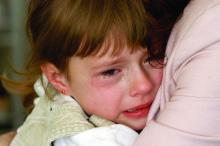Pediatricians have a central role in addressing the impact to children caused by armed conflict, including diagnosing and managing health conditions resulting from exposure to associated violence, according to a new American Academy of Pediatrics policy statement.
The recommendation, published in Pediatrics, emphasizes the need for child health professionals to understand the prevalence of armed conflict and its pervasive effects on children and to respond both domestically and globally to the problem. The AAP defines armed conflict as any organized dispute that involves the use of weapons, violence, or force, such as international wars, civil wars, ethnic conflicts, and violence associated with gangs and drug trafficking. Children effected by armed conflict may include refugees forcibly displaced from their countries, unaccompanied immigrant children, and former child combatants, known as child soldiers.
The policy details the various health effects triggered by armed conflict, including physical, mental, developmental, and behavioral health conditions in children as well as indirect effects through deprivation and toxic stress. Children affected by armed conflict, for example, are at increased risk for PTSD, depression, anxiety, and behavioral and psychosomatic problems, which can continue well into adulthood, according to the policy statement.
To address these effects, pediatricians should receive training on trauma-informed care that enables them to recognize the dynamics of traumatic life experiences among children exposed to armed conflict and provide optimal responses, the policy advises.
and can work to mitigate the effects of trauma, according to the policy. The AAP recommends that child health professionals be prepared to diagnose and offer initial management for conditions associated with exposure to armed conflict as well as partner with community mental and behavioral health providers to establish collaborative care networks, when possible. Other AAP recommendations in the policy statement include that child health professionals:
- Be trained to provide “culturally effective care,” defined as “the delivery of care within the context of appropriate physician knowledge, understanding, and appreciation of all cultural distinctions, leading to optimal health outcomes.”
- Collaborate with local refugee resettlement groups and other public and private sector organizations, such as schools, health systems, and social services, to “facilitate the integration of children and families into their communities and to help families meet unmet needs.”
- Receive special preparation before working with refugees in camps or in conflict settings to become familiar with recognized standards for child protection and to better manage the physical, sexual, and psychological injuries caused by armed conflict.
The policy statement goes on to offer recommendations for systems that serve children exposed to armed conflict, advising that such systems should protect exposed children from abuse and exploitation, and offer access to physical, mental, behavioral, developmental, oral, and rehabilitation health services.
Finally, the AAP stressed its support of policies that advance the health, development, well-being, and rights of children affected by armed conflict and displacement. The AAP states that children should not be separated from their families during displacement and resettlement, emphasizing that “an intact family is the optimal environment for children’s health and well-being” and that “in the event of separation, family reunification should be prioritized.”
In addition, the AAP strongly advocates that children affected by armed conflict have access to educational opportunities, noting that pediatricians can act as a voice toward this end.
“There is strong evidence to suggest that education for boys and girls at all levels reduces most forms of political violence,” the authors wrote. “However, education currently receives less than 2% of all humanitarian funding, and girls are more likely than boys to be excluded from education. Because education is a priority for many children and essential for their well-being, child health providers may advocate for their educational rights and access, especially during humanitarian emergencies.”
SOURCE: Shenoda S et al. Pediatrics. 2018 Nov 5. doi: 10.1542/peds.2018.2586.



